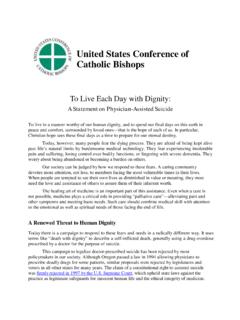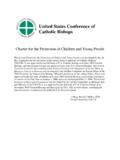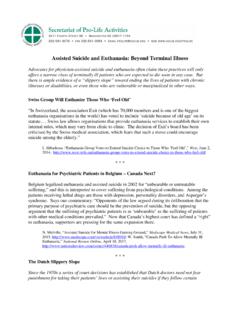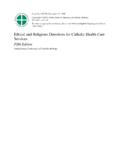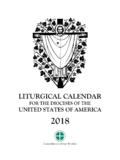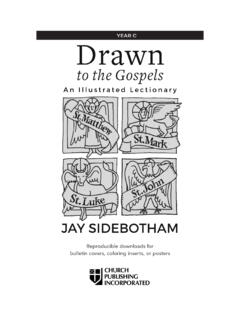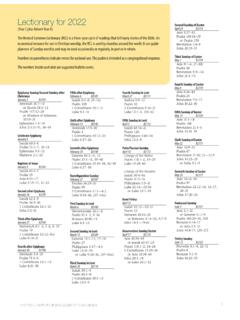Transcription of Ever Ancient, Ever New: The Art and Practice of Lectio Divina
1 Ever Ancient, Ever New: The Art and Practice of Lectio Divina St. Augustine of Hippo's phrase ever ancient, continued in the Middle Ages in religious orders, ever new describes the renewed interest in pray- such as the Benedictines and Carmelites, that ing with Scripture that has re-emerged in today's not only practiced Lectio Divina daily but passed Church. Around the country, parish Bible study this treasure from the past on to the next groups, small Christian communities, and other generations. The Practice of Lectio Divina is resur- faith sharers have rediscovered a simple, insight- facing today as a wonderful way to meditate on ful way to hear and experience the Word of God God's Word.
2 With one another through an ancient prayer form, Lectio Divina . What Does the Latin Name Mean? The Latin phrase Lectio Divina may be translated The reading from the Word of God at each Hour .. as divine reading. Lectio Divina is a method for and readings from the Fathers and spiritual masters praying with the Scriptures. As one reads and at certain Hours, reveal more deeply the meaning of invites the Word to become a transforming lens the mystery being celebrated, assist in understanding that brings the events of daily living into focus, the psalms, and prepare for silent prayer.
3 The Lectio div- one can come to live more deeply and find the ina, where the Word of God is so read and meditated that it becomes prayer, is thus rooted in the liturgical presence of God more readily in the events of celebration. each day. The method of Lectio Divina follows four steps: Lectio (reading), meditatio (meditation), Meditation engages thought, imagination, emotion, contemplatio (contemplation), and oratio (prayer). and desire. This mobilization of faculties is necessary in Lectio , or reading, is the first step in the order to deepen our convictions of faith, prompt the prayer process.
4 The early monks understood that conversion of our heart, and strengthen our will to fol- the fruitfulness of a monk's prayer depends upon low Christ. Christian prayer tries above all to meditate the simplicity, reverence, and openness to the on the mysteries of Christ, as in Lectio Divina or the rosa- Spirit with which the reader approaches the ry. This form of prayerful reflection is of great value, but Word of God. The goal of this reading is not to Christian prayer should go further: to the knowledge of rush through several chapters of Scripture. The the love of the Lord Jesus, to union with him.
5 Reader, rather than trying to take in large sections Catechism of the Catholic Church, 2nd ed., nos. 1177, 2708 of Scripture, adopts a reflective stance towards a (Washington, DC: Libreria Editrice Vaticana United short Scripture passage, pausing on a single word States Conference of Catholic Bishops, 2000). or phrase that resonates with the mind and heart. This reading leads to the second step, Lectio Divina is a form of meditation rooted known as meditatio Latin for meditation . in liturgical celebration that dates back to early which invites one to reflect upon what was read.
6 Monastic communities. It was a method practiced Ancient monks explained this process as a deep, by monks in their daily encounter with Scripture, unhurried thinking about the Word one has both as they prepared for the Eucharist and as read a rumination, somewhat like the way a they prayed the Liturgy of the Hours. Its use 11. the inspiration that comes from the Word of God most and that has the gracious capacity to refresh the heart and mind. Is cow chews the cud. As the Word is read in this ally. AsThe fourth one and final participant step, oratio, . remarked mean- to Sr.
7 Simons, Aroun step, the process of ruminating gradually draws OningSunday oration theorreadings prayer, areinvites already one's personal familiar to the pr the meditator's focus from concerns of the mind me. I hear the Word of God with my heart andand response to God. This response is dialogical catech to concerns of the heart. candeeper find be understood meaning as a conversation with Jesus in my life. between We p The Word moves a person more deeply with friends, as St. Teresa of Avila defined Sr. Rosemary Quigg, IHM, who ministers prayer. in mer a the third step, which the ancients called con- One takes the time to talk to God about St.
8 Rose of Lima Parish in Miami, Florida, hosts a what as Na templatio or contemplation. Contemplation was read,morning mid-week heard, orBible experienced, or about study session the for people spons is characterized by an openness of the heart, by of questions thatand varying ages have arisen in the occupations. Amongdepththeof one's par- Assoc which the reader experiences God as the One being. This response can become transformative ticipants are nurses coming home from night duty catech who prays within, who allows the person in con- andwhen one flight accepts the attendants on promptings their day off.
9 OfThe the Word par- echet templation to know the Word wordlessly and toward an embrace of all that life now ticipants Practice Lectio Divina as they reflect on holds. Colbe without image. By God's grace, contemplatio gives andOne can find prepare Godproclamation for the in the ups and of downs of life, the Scripture of NC. one a unique ability to connect one's newly dis- in times of joy and pain, as well as readings at the following sunday 's Eucharist. ordinary, D. covered insights to daily life experiences, with everyday Quigg oncemoments. heard a participant say, This is the Finnu the inspiration that comes from the Word of God most important thing we do here!
10 Chists and that has the gracious capacity to refresh the How Can Lectio Divina na to heart and mind. Is LectioEnrich DivinaParish Life? for Catechists? theme The fourth and final step, oratio, mean- In the the Around Churchtime today, of the Lectio Divina can provide new millennium, I had liturgi ing oration or prayer, invites one's personal a simple yet prayerful method the privilege of meeting with eleven diocesanfor faith shar- Sr. Qu response to God. This response is dialogical and ing among leaders catechetical Christiansfromataround every stage of life.




